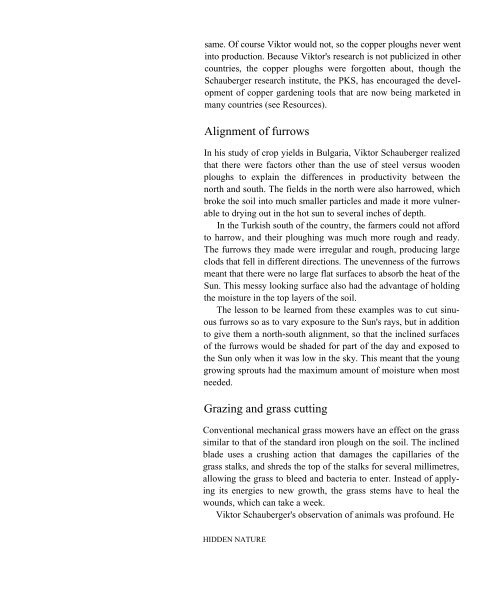levitational current - Free Energy
levitational current - Free Energy
levitational current - Free Energy
Create successful ePaper yourself
Turn your PDF publications into a flip-book with our unique Google optimized e-Paper software.
same. Of course Viktor would not, so the copper ploughs never went<br />
into production. Because Viktor's research is not publicized in other<br />
countries, the copper ploughs were forgotten about, though the<br />
Schauberger research institute, the PKS, has encouraged the development<br />
of copper gardening tools that are now being marketed in<br />
many countries (see Resources).<br />
Alignment of furrows<br />
In his study of crop yields in Bulgaria, Viktor Schauberger realized<br />
that there were factors other than the use of steel versus wooden<br />
ploughs to explain the differences in productivity between the<br />
north and south. The fields in the north were also harrowed, which<br />
broke the soil into much smaller particles and made it more vulnerable<br />
to drying out in the hot sun to several inches of depth.<br />
In the Turkish south of the country, the farmers could not afford<br />
to harrow, and their ploughing was much more rough and ready.<br />
The furrows they made were irregular and rough, producing large<br />
clods that fell in different directions. The unevenness of the furrows<br />
meant that there were no large flat surfaces to absorb the heat of the<br />
Sun. This messy looking surface also had the advantage of holding<br />
the moisture in the top layers of the soil.<br />
The lesson to be learned from these examples was to cut sinuous<br />
furrows so as to vary exposure to the Sun's rays, but in addition<br />
to give them a north-south alignment, so that the inclined surfaces<br />
of the furrows would be shaded for part of the day and exposed to<br />
the Sun only when it was low in the sky. This meant that the young<br />
growing sprouts had the maximum amount of moisture when most<br />
needed.<br />
Grazing and grass cutting<br />
Conventional mechanical grass mowers have an effect on the grass<br />
similar to that of the standard iron plough on the soil. The inclined<br />
blade uses a crushing action that damages the capillaries of the<br />
grass stalks, and shreds the top of the stalks for several millimetres,<br />
allowing the grass to bleed and bacteria to enter. Instead of applying<br />
its energies to new growth, the grass stems have to heal the<br />
wounds, which can take a week.<br />
Viktor Schauberger's observation of animals was profound. He<br />
HIDDEN NATURE








![The Big Lie 9-11 and Government Complicity in Mass Murder [PDF]](https://img.yumpu.com/50957077/1/190x245/the-big-lie-9-11-and-government-complicity-in-mass-murder-pdf.jpg?quality=85)








